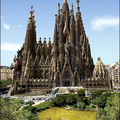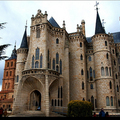Destinations / The most beautiful cathedrals of Spain / Santiago de Compostela Cathedral in Spain
Santiago de Compostela Cathedral in Spain
According to the legend, the Cathedral of Santiago de Compostela, a town located in the Spanish province of Galicia, houses the relics of one of the Holy Apostles of Christ, St. James (Santiago in Spanish), who died in 44 AD in Jerusalem.
In the ninth century, King Alfonso II of Asturia had built a small church on the site of the tomb, discovered in 819 AD. This was destroyed in 997 by the Moorish army of al-Mansur, but the relics of the Apostle remained intact. The cathedral was rebuilt and expanded in subsequent years, the city of Santiago de Compostela becoming the most important Christian pilgrimage site after Jerusalem and Rome, where the Holy Sepulchre of Christ and, respectively, St. Peter's tomb are located. Medieval pilgrims used to wander for several month on St. James Road to reach Santiago de Compostela Cathedral.
Despite its baroque façade, the cathedral is built predominantly in Romanesque style and it is one of the most beautiful Romanesque cathedrals in Spain. Its construction began in 1060, under the reign of Alfonso VI and ended in 1211. Many elements were added later, culminating with the dramatic transformation of the exterior in baroque style, which took place between XVI-XVIIIth century . The Romanesque interior was fully preserved.
The relics of St. James, raison d'être of the cathedral, were lost in 1700, after being hidden because of an English invasion. Fortunately, they were rediscovered in 1879 during some reconstruction works, along with other relics of two of his disciples. Those of St. James have been identified by a church in Tuscany, who owned a part of the skull that fit perfectly into a hole of one of the skulls found. Relics’ identity was confirmed by Pope Leo XIII and later by Pope John Paul II, who made the pilgrimage to Santiago de Compostela in 1982.
Santiago de Compostela annually attracts millions of believers who set off on a long journey of spiritual rediscovery. The old part of the town Santiago de Compostela was included in World Heritage sites protected by UNESCO since 1985.




























